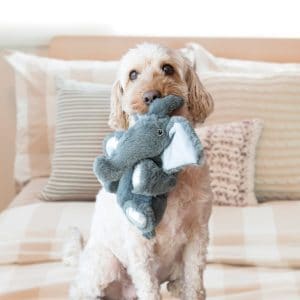
Adopting A Rescue Dog: What to expect
The “3-3-3 Rule”, plus, resources for your new dog’s challenging behaviors.
Have you recently adopted a new dog? Are you a little nervous about how they will settle into your home? It’s a big change for both of you, and adjustments will take some time.
You might have heard of the 3-3-3 Rule. If you aren’t familiar with this rule, it is a valuable tool to use when you take home your new pup! The 3-3-3 rule is designed to help set expectations for the first 3 days, the first 3 weeks, and the first 3 months of your new pet’s transition into your home.
In the first 3 days: 
- Create a Comforting Space. Your dog might feel overwhelmed, scared, and unsure- make sure to give them a space of their own and something comforting like their own bed and plush toy to snuggle up to. This KONG Comfort Kiddos Bear has a removable, low-tone squeaker which is great for the first few days with a shy pet. Tip: If you have children, talk to them about your new pet in a way that they will relate to their own feelings of nervousness.
- Meet & Greet. If you have another dog, it’s best for them to meet outside of the home, even if they’ve already met at the shelter. One way to do this is to have the dogs walk on opposite sides of a residential street with another family member or friend, in the same direction, getting closer as you go, then eventually making your way to the backyard or area near a door of your home. Watch this KONG Classroom video: Dog & Cat Introductions with Dr. Karen B. London, to learn the correct way to introduce dogs with dogs, and dogs and cats, and to learn what to avoid.
- Baby Steps. Make sure to give your dog a tour of your home’s exterior before you head inside so they get the new smells, have a chance to go potty, and get the lay of the land.
- Hide & Seek. Your dog might not be comfortable coming out of their shell and may refrain from eating or drinking at first. This is normal behavior for a dog who has gone through a lot of changes. Speak gently, in a calm tone until they warm up to you and your family. Your dog may hide under tables, chairs, or in their crate. You can invite them out and try to entice them with treats, but never force them out of their secure space until they are ready on their own.
- Testing Boundaries. For parents of human children, you may be familiar with this one already – with ‘threenagers’ or teenagers! Try to have patience with your new fur child as they navigate what is acceptable and what’s not in their new home.
In the first 3 weeks:
- Settling In. Your dog should start settling in and feeling at home.
- Routines. This is a great time to establish daily routines for feeding, walking, playing, and downtime.
- Familiar Environment. Your dog is learning their new environment and you may notice them anticipating your movements a little bit more.
- Personality & Quirks. Your dog’s personality may begin to shine through! This is when you might also start to see previously learned behaviors surface. Just remember, it is never too late to teach your dog new behaviors. Give your dog some time to work out the kinks – this is all still very new to them, and some behaviors may dissipate with more time and effort on your part.
In the first 3 months:
- Set Routines. You and your dog’s routines should be set by now. They should be anticipating your cues for walks, feeding, treats, etc.
- Bonding & Security. You will have started to build a bond by now which gives them a sense of security. They know they are home, and you are their family.
- Comfort & Relaxation. Your dog should feel a sense of comfort and the ability to relax at this point.
Class is in session for your dog and you. We conducted a poll with over 100 shelters and rescue groups to determine the top reasons dogs are returned after their adoption day. To help navigate each of these common issues, we’ve included a valuable resource from the KONG Classroom and KONG Library to help guide you and your dog to living happily ever after. Make sure to read and watch these resources with a pen and paper at hand to take notes and practice what you’ve learned. 
1. Separation Anxiety – How To Manage Separation Anxiety In Dogs 📖
2. Boredom – Boredom Busters For Your Dog 📖
3. Digging – How To Help With Digging 📺
4. Destructive Chewing – This is a two-part video series 📺
5. Place Training – For Barking, begging, jumping, and more – Teaching A Place Cue 📺
6. Crate Training – Crate Training Basics 📺 Crate Training Using A KONG 📖
It is important to know that every dog is an individual, and challenges are normal when you integrate any new pet into your life. If you ever feel like your dog’s behavior is more than you can handle, we encourage you to find a trainer that specializes in your dog’s needs. Finding the right tools and resources will help you and your new dog strike a balance that fits your lifestyle, and give you both a lifetime of happiness.
Suggested KONG Library read: Puppy Proofing Your Home Before you bring your new dog home, prepare for your family and dog’s safety!
 from Laurel Lewis
from Laurel Lewis



